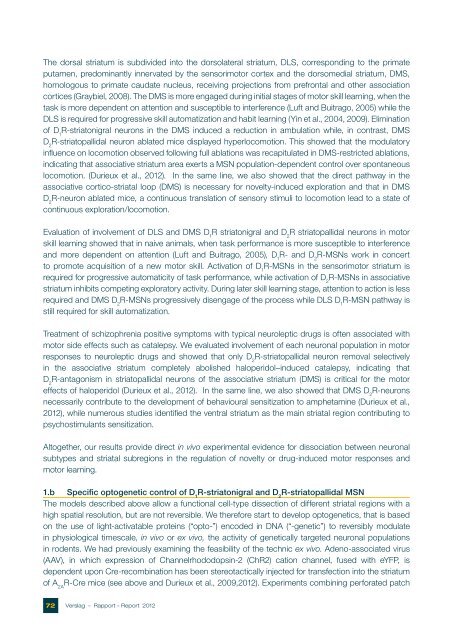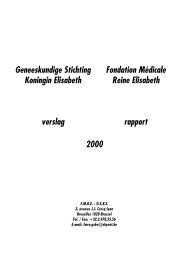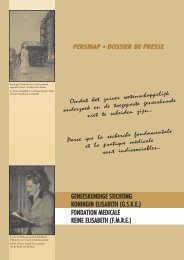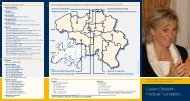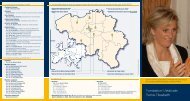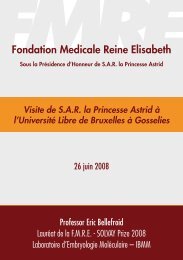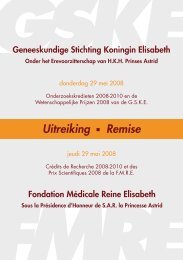Verslag – Rapport – Bericht – Report - GSKE - FMRE
Verslag – Rapport – Bericht – Report - GSKE - FMRE
Verslag – Rapport – Bericht – Report - GSKE - FMRE
Create successful ePaper yourself
Turn your PDF publications into a flip-book with our unique Google optimized e-Paper software.
The dorsal striatum is subdivided into the dorsolateral striatum, DLS, corresponding to the primate<br />
putamen, predominantly innervated by the sensorimotor cortex and the dorsomedial striatum, DMS,<br />
homologous to primate caudate nucleus, receiving projections from prefrontal and other association<br />
cortices (Graybiel, 2008). The DMS is more engaged during initial stages of motor skill learning, when the<br />
task is more dependent on attention and susceptible to interference (Luft and Buitrago, 2005) while the<br />
DLS is required for progressive skill automatization and habit learning (Yin et al., 2004, 2009). Elimination<br />
of D 1 R-striatonigral neurons in the DMS induced a reduction in ambulation while, in contrast, DMS<br />
D 2 R-striatopallidal neuron ablated mice displayed hyperlocomotion. This showed that the modulatory<br />
influence on locomotion observed following full ablations was recapitulated in DMS-restricted ablations,<br />
indicating that associative striatum area exerts a MSN population-dependent control over spontaneous<br />
locomotion. (Durieux et al., 2012). In the same line, we also showed that the direct pathway in the<br />
associative cortico-striatal loop (DMS) is necessary for novelty-induced exploration and that in DMS<br />
D 2 R-neuron ablated mice, a continuous translation of sensory stimuli to locomotion lead to a state of<br />
continuous exploration/locomotion.<br />
Evaluation of involvement of DLS and DMS D 1 R striatonigral and D 2 R striatopallidal neurons in motor<br />
skill learning showed that in naive animals, when task performance is more susceptible to interference<br />
and more dependent on attention (Luft and Buitrago, 2005), D 1 R- and D 2 R-MSNs work in concert<br />
to promote acquisition of a new motor skill. Activation of D 1 R-MSNs in the sensorimotor striatum is<br />
required for progressive automaticity of task performance, while activation of D 2 R-MSNs in associative<br />
striatum inhibits competing exploratory activity. During later skill learning stage, attention to action is less<br />
required and DMS D 2 R-MSNs progressively disengage of the process while DLS D 1 R-MSN pathway is<br />
still required for skill automatization.<br />
Treatment of schizophrenia positive symptoms with typical neuroleptic drugs is often associated with<br />
motor side effects such as catalepsy. We evaluated involvement of each neuronal population in motor<br />
responses to neuroleptic drugs and showed that only D 2 R-striatopallidal neuron removal selectively<br />
in the associative striatum completely abolished haloperidol<strong>–</strong>induced catalepsy, indicating that<br />
D 2 R-antagonism in striatopallidal neurons of the associative striatum (DMS) is critical for the motor<br />
effects of haloperidol (Durieux et al., 2012). In the same line, we also showed that DMS D 2 R-neurons<br />
necessarily contribute to the development of behavioural sensitization to amphetamine (Durieux et al.,<br />
2012), while numerous studies identified the ventral striatum as the main striatal region contributing to<br />
psychostimulants sensitization.<br />
Altogether, our results provide direct in vivo experimental evidence for dissociation between neuronal<br />
subtypes and striatal subregions in the regulation of novelty or drug-induced motor responses and<br />
motor learning.<br />
1.b Specific optogenetic control of D 1 R-striatonigral and D 2 R-striatopallidal MSN<br />
The models described above allow a functional cell-type dissection of different striatal regions with a<br />
high spatial resolution, but are not reversible. We therefore start to develop optogenetics, that is based<br />
on the use of light-activatable proteins (“opto-”) encoded in DNA (“-genetic”) to reversibly modulate<br />
in physiological timescale, in vivo or ex vivo, the activity of genetically targeted neuronal populations<br />
in rodents. We had previously examining the feasibility of the technic ex vivo. Adeno-associated virus<br />
(AAV), in which expression of Channelrhododopsin-2 (ChR2) cation channel, fused with eYFP, is<br />
dependent upon Cre-recombination has been stereotactically injected for transfection into the striatum<br />
of A 2A R-Cre mice (see above and Durieux et al., 2009,2012). Experiments combining perforated patch<br />
72<br />
<strong>Verslag</strong> <strong>–</strong> <strong>Rapport</strong> <strong>–</strong> <strong>Report</strong> 2012


